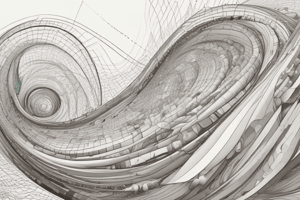Podcast
Questions and Answers
What is the main purpose of differentiation?
What is the main purpose of differentiation?
- To model the motion of objects in physics
- To design electronic circuits
- To find the maximum and minimum values of a function
- To study the behavior of functions, including their maximum and minimum values, and the shape of their graphs (correct)
What is the formula for the derivative of f(x) = x^n?
What is the formula for the derivative of f(x) = x^n?
- f'(x) = nx^(n+1)
- f'(x) = 2x^n
- f'(x) = nx^(n-1) (correct)
- f'(x) = x^(2n)
What is the formula for the derivative of f(x) = u(x)v(x)?
What is the formula for the derivative of f(x) = u(x)v(x)?
- f'(x) = u'(x)v(x) - u(x)v'(x)
- f'(x) = u(x)v'(x)
- f'(x) = u'(x)v'(x)
- f'(x) = u'(x)v(x) + u(x)v'(x) (correct)
What is the geometric interpretation of the derivative of a function at a point?
What is the geometric interpretation of the derivative of a function at a point?
What is the second derivative of a function used to determine?
What is the second derivative of a function used to determine?
What is one of the applications of differentiation in physics?
What is one of the applications of differentiation in physics?
What is the formula for the derivative of f(x) = u(x)/v(x)?
What is the formula for the derivative of f(x) = u(x)/v(x)?
What is the application of differentiation in engineering?
What is the application of differentiation in engineering?
What is the formula for the derivative of f(x) = g(h(x))?
What is the formula for the derivative of f(x) = g(h(x))?
What is one of the applications of differentiation in economics?
What is one of the applications of differentiation in economics?
Study Notes
What is Differentiation?
- Differentiation is a process of finding the derivative of a function.
- It is a measure of how a function changes as its input changes.
- It is used to study the behavior of functions, including their maximum and minimum values, and the shape of their graphs.
Rules of Differentiation
- Power Rule: If
f(x) = x^n, thenf'(x) = nx^(n-1). - Product Rule: If
f(x) = u(x)v(x), thenf'(x) = u'(x)v(x) + u(x)v'(x). - Quotient Rule: If
f(x) = u(x)/v(x), thenf'(x) = (u'(x)v(x) - u(x)v'(x)) / v(x)^2. - Chain Rule: If
f(x) = g(h(x)), thenf'(x) = g'(h(x)) \* h'(x).
Geometric Interpretation of Differentiation
- The derivative of a function at a point represents the slope of the tangent line to the graph of the function at that point.
- The derivative can be used to find the maximum and minimum values of a function, and to determine the shape of its graph.
Higher-Order Derivatives
- The second derivative of a function represents the rate of change of the first derivative, and can be used to determine the concavity of the graph of the function.
- Higher-order derivatives can be used to study the behavior of functions in more detail.
Applications of Differentiation
- Optimization: Differentiation is used to find the maximum and minimum values of functions, which is important in many fields, such as economics and physics.
- Physics: Differentiation is used to model the motion of objects, including the acceleration and velocity of particles and the curvature of space-time.
- Engineering: Differentiation is used to design and optimize systems, such as electronic circuits and mechanical systems.
What is Differentiation?
- Differentiation is a process of finding the derivative of a function to measure how it changes as its input changes.
- It helps study the behavior of functions, including their maximum and minimum values, and the shape of their graphs.
Rules of Differentiation
- Power Rule: If a function is
f(x) = x^n, its derivative isf'(x) = nx^(n-1). - Product Rule: If a function is
f(x) = u(x)v(x), its derivative isf'(x) = u'(x)v(x) + u(x)v'(x). - Quotient Rule: If a function is
f(x) = u(x)/v(x), its derivative isf'(x) = (u'(x)v(x) - u(x)v'(x)) / v(x)^2. - Chain Rule: If a function is
f(x) = g(h(x)), its derivative isf'(x) = g'(h(x)) * h'(x).
Geometric Interpretation of Differentiation
- The derivative of a function at a point represents the slope of the tangent line to the graph of the function at that point.
- The derivative helps find the maximum and minimum values of a function and determines the shape of its graph.
Higher-Order Derivatives
- The second derivative of a function represents the rate of change of the first derivative.
- The second derivative helps determine the concavity of the graph of the function.
- Higher-order derivatives help study the behavior of functions in more detail.
Applications of Differentiation
- Optimization: Differentiation is used to find the maximum and minimum values of functions, which is essential in economics and physics.
- Physics: Differentiation models the motion of objects, including acceleration and velocity of particles and the curvature of space-time.
- Engineering: Differentiation is used to design and optimize systems, such as electronic circuits and mechanical systems.
Studying That Suits You
Use AI to generate personalized quizzes and flashcards to suit your learning preferences.
Description
Learn about the process of differentiation, its importance in studying function behavior, and the rules of differentiation including power, product, and quotient rules.




